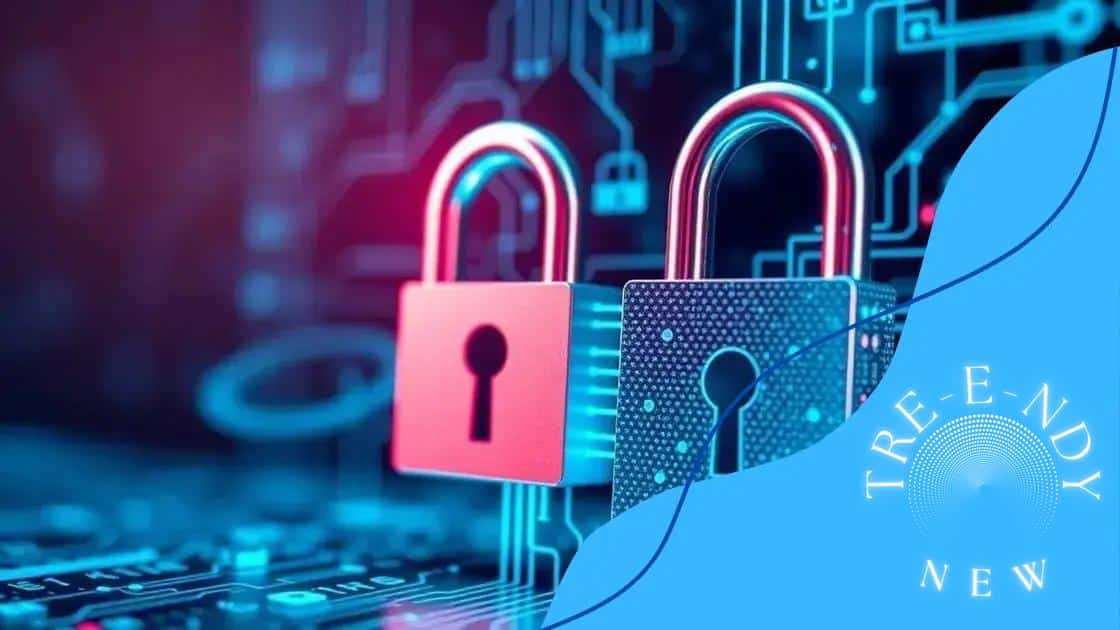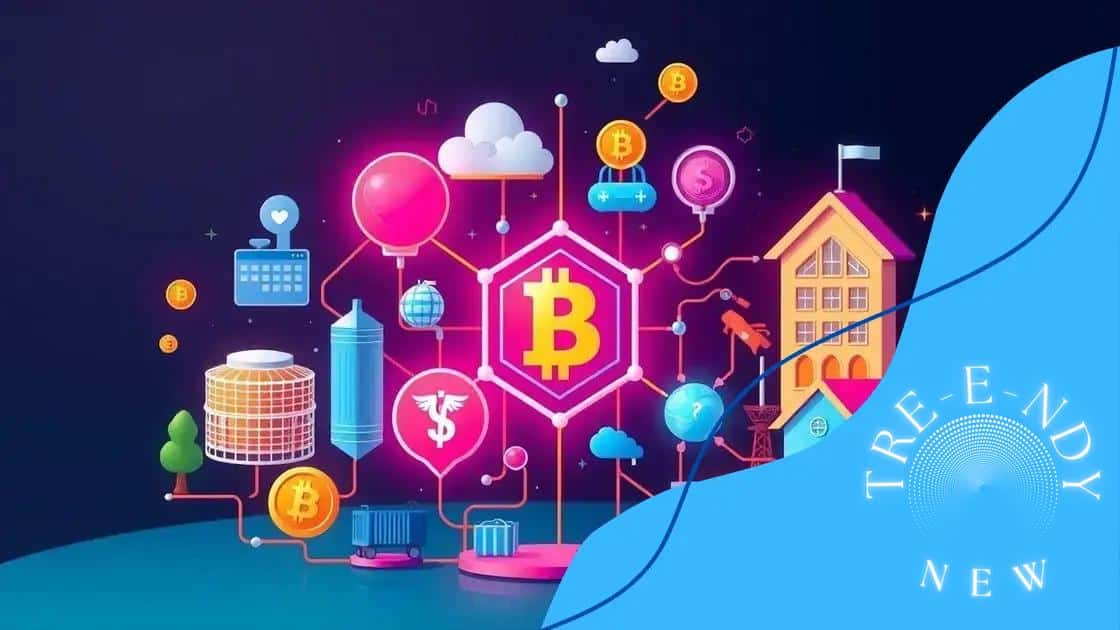Blockchain for credential verification: enhancing trust and security

Blockchain technology enhances credential verification by providing a secure, transparent, and efficient way to authenticate identities, reduce fraud, and improve user control over personal data.
Blockchain for credential verification is opening new doors for security and trust in identity management. Have you ever questioned how safe your credentials truly are? This technology could change everything.
Understanding blockchain technology
Understanding blockchain technology is crucial in today’s digital landscape. This innovative solution offers a decentralized approach to data management, ensuring transparency and security. It operates as a public ledger that records transactions in a way that is immutable.
To grasp blockchain, it’s important to recognize its core components.
Key Features of Blockchain
Here are some key features that make blockchain technology unique:
- Decentralization: Unlike traditional systems, it does not rely on a central authority.
- Transparency: All transactions are visible to participants, enhancing trust.
- Immutability: Once recorded, data cannot be altered or deleted.
- Security: Cryptographic techniques protect data from unauthorized access.
Next, let’s explore how blockchain works. At its core, it consists of a chain of blocks. Each block contains a group of transactions, and every block is linked to the previous one, forming an unbreakable chain. This structure ensures that any attempt to modify information would require altering every subsequent block, making fraud nearly impossible.
The implications of blockchain are vast. Industries ranging from finance to healthcare are leveraging this technology to improve their processes. Consider the financial sector; banks are exploring blockchain for faster transactions with lower fees. In healthcare, patient records can be securely shared among providers while maintaining privacy.
Furthermore, as more entities adopt blockchain technology, we are likely to see increased collaboration across industries. The potential for innovation is enormous, as businesses discover new ways to utilize blockchain for efficiency and accountability.
Benefits of blockchain for verification
The benefits of blockchain for verification are transforming how we handle data integrity and security. By utilizing a decentralized structure, blockchain minimizes the risks associated with centralization. This technology promotes trust among users and improves data reliability.
One of the core advantages of using blockchain is enhanced security. Traditional verification processes often expose data to risks, such as hacking and unauthorized access. With blockchain, data is encrypted and distributed across a network, making it extremely difficult for malicious actors to interfere.
Key Benefits of Using Blockchain for Verification
Consider these benefits when thinking about blockchain:
- Transparency: All participants can view transactions, which helps in accountability.
- Efficiency: Reduces the time for verification as it automates processes.
- Cost-effectiveness: Lowers operational costs by eliminating intermediaries.
- Auditability: Provides traceable records that improve compliance and audits.
Moreover, using blockchain for verification means trusting a system built on algorithms and consensus rather than people. This minimizes human error and enhances overall reliability. For instance, in industries like finance, blockchain allows quicker and more reliable transactions, reducing the chances of fraud.
Organizations are increasingly adopting this technology for its ability to streamline operations. With blockchain, it is easier to verify credentials and other important information, which saves time and resources. For example, educational institutions can directly verify a graduate’s credentials, simplifying the hiring process.
Real-world applications of blockchain

Real-world applications of blockchain are expanding rapidly as businesses recognize its potential. This technology is not just a buzzword; it is actively transforming various industries by providing secure and efficient solutions.
In finance, for instance, blockchain enables faster payment processing. Transactions that once took days can now be completed in a matter of minutes. This shift not only saves time but also reduces fees associated with traditional banking methods.
Blockchain Applications Across Industries
Here are several significant applications of blockchain technology:
- Supply Chain Management: Companies use blockchain to improve transparency and traceability, ensuring that products are authentic and ethically sourced.
- Healthcare: Patient records can be securely shared and verified among providers, leading to improved patient care and privacy.
- Real Estate: Blockchain simplifies property transactions by enabling smart contracts, reducing the need for intermediaries.
- Voting Systems: With blockchain, voting processes can be made more secure and transparent, reducing the likelihood of fraud.
Manufacturers are incorporating blockchain to track inventory and manage logistics. This leads to more efficient operations and reduced costs. In the energy sector, blockchain facilitates peer-to-peer energy trading, allowing consumers to buy and sell excess energy without relying on central authorities.
Moreover, as more businesses adopt blockchain technology, the potential for innovation grows. Startups and established companies alike are exploring new ways to leverage this technology for competitive advantage. The future looks bright as industries evolve and adapt to the benefits that blockchain has to offer.
Challenges in credential verification
Challenges in credential verification are significant barriers to effective identity management. While blockchain technology can streamline verification processes, it doesn’t eliminate all obstacles. Understanding these challenges is essential for implementing successful solutions.
One major issue is the lack of standardization across different industries and organizations. This inconsistency makes it difficult to establish a universal system for verification. Without agreed-upon protocols, verifying credentials can become a cumbersome process.
Key Challenges in Credential Verification
Here are some critical challenges faced in the realm of credential verification:
- Security Threats: Although blockchain enhances security, it is not immune to cyber attacks.
- Data Privacy: Protecting sensitive information while ensuring transparency can be tricky.
- Interoperability: Different systems need to work together, yet many platforms are isolated.
- Regulatory Compliance: Meeting regulations can be complex, varying significantly by region and industry.
Moreover, there is the challenge of user adoption. Many users may not understand how blockchain works or the benefits it provides. This lack of understanding can lead to resistance, making it harder to implement these solutions widely.
As organizations strive to overcome these challenges, collaboration becomes vital. By working together, stakeholders can develop standardized practices that facilitate smoother verification processes. The goal should be to create a secure and efficient system that maintains the integrity and authenticity of credentials.
The future of credential verification with blockchain
The future of credential verification with blockchain looks promising as technological advancements continue to reshape how identity management is approached. As more organizations adopt this technology, significant improvements in security, efficiency, and user experience are expected.
One exciting possibility is the use of smart contracts. These self-executing contracts ensure that verification processes occur automatically, reducing the need for intermediaries. This can make verifying credentials faster and less expensive, thus enhancing overall efficiency.
Trends Shaping the Future of Credential Verification
Here are some key trends that may define the future of credential verification:
- Increased Adoption: More businesses will likely implement blockchain, leading to standardized practices across industries.
- Enhanced Interoperability: Future systems will likely focus on seamless communication between different platforms, facilitating better verification.
- Focus on User Privacy: Solutions will emerge that prioritize users’ control over their data, allowing individuals to share only necessary information.
- Regulatory Developments: As blockchain technologies evolve, we can expect clearer regulations surrounding data protection and verification processes.
Furthermore, the integration of artificial intelligence with blockchain can open new avenues for automated verification tasks. AI can analyze patterns and flag suspicious activities, improving security and trust in the system.
As technology evolves, we may also witness the rise of decentralized identity solutions, where individuals have ownership of their credentials. This trend shifts power back to users, enabling them to present their verified data without relying on centralized authorities. Such innovations demonstrate the transformative potential of blockchain in credential verification.
FAQ – Frequently Asked Questions about Credential Verification with Blockchain
What is blockchain technology?
Blockchain is a decentralized digital ledger that records transactions across many computers securely and transparently.
How does blockchain improve credential verification?
Blockchain enhances security, transparency, and efficiency in verifying credentials, making it harder for fraud to occur.
What are some challenges of using blockchain for verification?
Challenges include ensuring data privacy, achieving standardization across platforms, and addressing security threats.
What is the future of credential verification with blockchain?
The future includes increased adoption, improved user privacy, more efficient processes, and greater standardization across industries.





